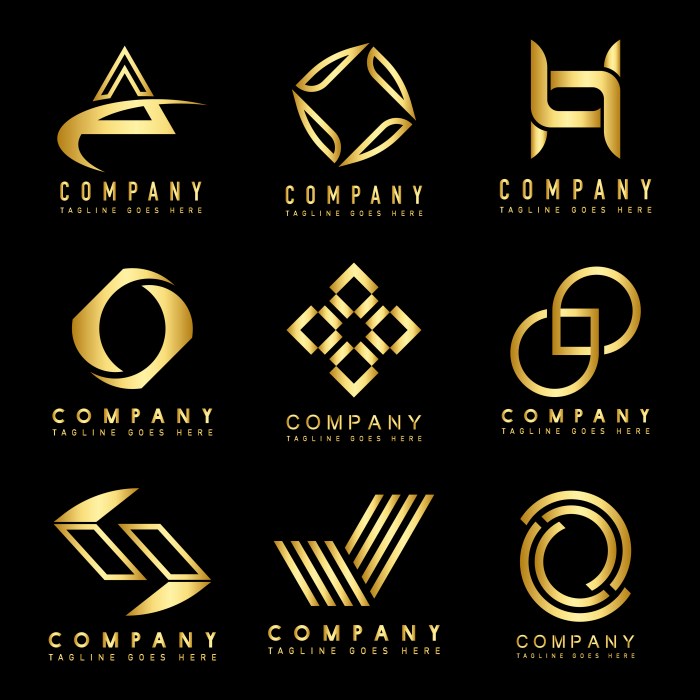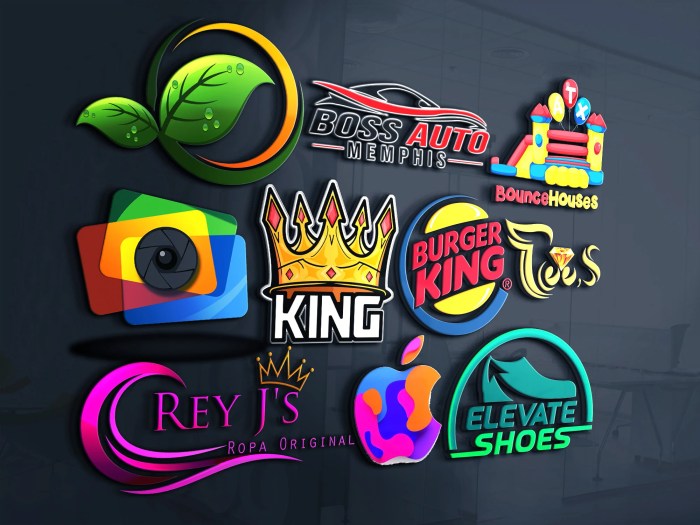
Beginning with Logo design trends 2025, the narrative unfolds in a compelling and distinctive manner, drawing readers into a story that promises to be both engaging and uniquely memorable.
As we look ahead to 2025, logo design is set to evolve, driven by technological advancements and a deeper understanding of branding consistency. This year will showcase emerging styles that not only capture attention but also reflect the essence of brands in a dynamic marketplace.
Logo Design Trends 2025

As we step into 2025, logo design is poised for exciting transformations shaped by societal shifts, advancements in technology, and evolving consumer preferences. This year promises to be a canvas for creativity, where brands not only seek to stand out but also to resonate deeply with their audience. The landscape will be marked by emerging styles that reflect contemporary values and the digital age’s influence.
Emerging Styles in Logo Design for 2025
The logo designs of 2025 are expected to showcase a blend of minimalism and boldness, with a strong focus on versatile aesthetics. As society moves towards more sustainable practices, logos will likely reflect eco-consciousness, utilizing earthy tones and organic shapes. Additionally, there will be a rise in dynamic logos that change appearance based on context, enhancing their relevance and engagement with users.
- Geometric Shapes: Expect to see a resurgence in geometric patterns, which offer a modern, polished look. Brands will use these shapes to create distinctive yet straightforward logos that are memorable.
- Retro and Nostalgic Elements: Drawing inspiration from past styles, retro designs will make a comeback, evoking familiarity and comfort while appealing to a sense of nostalgia.
- Animated Logos: With advancements in technology, brands will increasingly incorporate animations into their logos, creating dynamic visual identities that captivate and retain viewer attention.
- Hand-drawn Aesthetics: Personalization in design will take center stage, with many brands opting for custom, hand-drawn elements that convey authenticity and uniqueness.
Impact of Technology on Logo Design Trends
Technology plays a crucial role in shaping logo design trends, with tools and platforms evolving to enhance the creative process. The rise of AI and machine learning is allowing designers to experiment with innovative styles, generating unique concepts and automating repetitive tasks. This not only streamlines workflow but also encourages creativity by freeing designers to focus on strategic elements.
“The integration of technology in design is not just about tools, but about creating experiences that resonate with consumers.”
Moreover, the increasing importance of digital presence means logos must be adaptable across various platforms and mediums. For instance, responsive logos that adjust in size and complexity based on the device being used will become more common, ensuring consistency without compromising design integrity.
Importance of Branding Consistency in Modern Logos
In today’s competitive market, branding consistency is paramount. A cohesive logo not only aids in brand recognition but also builds trust with consumers. As brands navigate various channels—from social media to packaging—maintaining a uniform visual identity becomes crucial.
- Enhances Recognition: Consistent logos are easier for consumers to recognize, fostering familiarity that can lead to increased loyalty.
- Supports Brand Messaging: A well-designed logo aligns with the brand’s message and values, reinforcing its identity in the marketplace.
- Facilitates Marketing Efforts: A cohesive look across all marketing materials simplifies campaigns, making them more effective and impactful.
- Adapts to New Trends: While maintaining consistency, a flexible logo can evolve with design trends, ensuring the brand remains relevant and contemporary.
Real Estate Branding through Logo Design
In the competitive world of real estate, branding plays a crucial role in attracting and retaining clients. A well-designed logo serves as the visual cornerstone of a real estate agency’s identity, influencing consumer perception and establishing trust. This is especially important in an industry where reputation and recognizability can significantly impact business success.Logo designs can profoundly influence consumer perceptions in real estate.
A logo is often the first point of contact potential clients have with a brand, and it communicates essential attributes such as professionalism, reliability, and innovation. A strong logo can evoke emotions and associations, making it easier for clients to remember and choose a particular agency over competitors. For example, a sleek, modern logo may resonate with younger homebuyers, while a traditional, classic logo might appeal to older, more established clients.
This connection fosters trust, as consumers often associate professional branding with quality service and successful transactions.
Comparison of Logo Styles Used by Successful Real Estate Agencies
Different real estate agencies employ various logo styles that reflect their brand identity and market positioning. Understanding these styles can provide insights into how logo design impacts consumer perception and agency success.The following Artikels some prevalent logo styles and their implications:
- Minimalist Logos: Many successful real estate agencies are embracing minimalist designs that emphasize simplicity and elegance. These logos often use clean lines and muted colors to convey a modern aesthetic. For instance, agency XYZ uses a straightforward sans-serif font with an abstract house icon, symbolizing both clarity and contemporary values.
- Luxury Branding: High-end real estate firms often utilize logos that incorporate gold or silver elements, sophisticated typography, and intricate designs. For example, Agency ABC’s logo features a stylized monogram in a luxurious gold foil, representing exclusivity and high value.
- Nature-Inspired Logos: Agencies focusing on eco-friendly properties might opt for logo designs that integrate natural elements, such as leaves or earth tones. Agency DEF effectively uses a green color palette and a tree icon, promoting their commitment to sustainability and appealing to environmentally conscious clients.
The choice of logo style not only affects how clients perceive the agency but also aligns with the market segment that the agency aims to attract.
“A logo is more than just a symbol; it’s the first impression that can make or break a client’s trust in a real estate agency.”
Relationship Between Logo Design and Real Estate Market Positioning
The relationship between logo design and market positioning in real estate is pivotal. An effective logo can serve as a strategic tool to differentiate an agency from its competitors, thereby solidifying its position within the market. Logos that are distinct and memorable contribute to a stronger brand identity, which can lead to increased market share and consumer loyalty.Agencies that operate in niche markets, such as luxury or historical properties, often utilize logos that reflect their specialization.
For example, a company targeting high-net-worth individuals might invest in a logo that embodies elegance and sophistication, indicating their ability to handle premium transactions. Conversely, an agency that aims to appeal to first-time homebuyers might use a more approachable and friendly logo design, making the brand feel accessible and relatable.By understanding their target market and aligning their logo design with consumer expectations, real estate agencies can effectively enhance their brand perception.
This strategic alignment ensures that their visual identity resonates with their audience, ultimately leading to greater success in a competitive marketplace.
Integrating Logo Design with Real Estate Marketing Strategies
In the competitive realm of real estate, distinguishing oneself is crucial. A well-crafted logo serves as the cornerstone of branding, encapsulating the essence of a real estate business and enhancing its visibility. By integrating logo design into marketing strategies, real estate agents can create a cohesive and powerful brand presence that resonates with potential clients.Effective integration of logo design into marketing materials is essential for building a recognizable brand.
This involves utilizing the logo across various platforms, ensuring consistency in visual identity, and reinforcing brand values through design. Below are key methods to incorporate logos seamlessly into real estate marketing materials.
Methods for Incorporating Logo Design
A strong branding strategy hinges on the consistent use of your logo across all marketing materials. Here are effective methods to incorporate logo design:
- Business Cards: Design business cards that prominently feature the logo. This creates a lasting impression during networking events.
- Property Signage: Ensure that all for-sale signs include the logo, making properties instantly recognizable.
- Digital Brochures: Include the logo on digital brochures and listings to enhance brand recognition in the digital space.
- Social Media Graphics: Utilize the logo in profile images and post graphics on platforms like Instagram and Facebook to maintain a cohesive online presence.
- Email Signatures: Incorporate the logo in email signatures to enhance professionalism and brand visibility in correspondence.
Key Elements of a Cohesive Branding Strategy
A cohesive branding strategy unifies the logo with other branding elements to create a strong market presence. The following components are significant in aligning logo design with overall brand strategy:
- Color Palette: Choose a color palette that complements the logo and reflects the brand’s personality. Consistent color usage across materials reinforces brand identity.
- Typography: Select fonts that match the logo’s style, ensuring readability and consistency in all texts related to the brand.
- Brand Message: Develop a clear brand message that aligns with the logo’s visual identity, creating an emotional connection with clients.
- Visual Elements: Employ complementary visuals such as icons and imagery that resonate with the logo’s design to create a comprehensive branding experience.
Innovative Ways to Use Logos in Digital Marketing
In the digital landscape, logos can be utilized in innovative ways to enhance marketing efforts. Effective strategies include:
- Website Design: Place the logo prominently on the website’s homepage and in the header of each page, ensuring it is linked back to the homepage for easy navigation.
- Virtual Tours: Integrate the logo into virtual tour videos, creating a branded experience as potential buyers navigate properties.
- Targeted Ads: Use the logo in targeted online advertisements, ensuring consistency in branding and making ads easily recognizable.
- Content Marketing: Feature the logo on blog posts and articles that highlight market trends, establishing authority and a consistent brand voice.
- Webinars and Videos: Utilize the logo in the opening and closing frames of video content, reinforcing brand presence in educational materials.
Effective branding in real estate hinges on consistency in logo usage across all platforms to create a unified and memorable client experience.
Closing Summary

In summary, Logo design trends 2025 highlight the importance of innovation in branding as we adapt to new technologies and consumer preferences. By integrating these trends into effective real estate marketing strategies, businesses can enhance their brand presence and foster stronger connections with their audience.
FAQ Section
What are the key logo design trends for 2025?
Key trends include minimalist designs, bold typography, and the use of gradients and vibrant colors.
How does technology influence logo design?
Technology enhances logo design through tools like AI and software that allow for more creative possibilities and refined execution.
Why is branding consistency important in logo design?
Branding consistency helps maintain consumer trust and recognition, ensuring that logos effectively represent the brand across various platforms.
How can logo design affect consumer perception in real estate?
A well-designed logo can evoke feelings of professionalism and reliability, which are crucial in influencing consumer decisions in real estate.
What methods can real estate agents use to incorporate logos into marketing?
Agents can use logos on business cards, social media profiles, property listings, and promotional materials to strengthen brand identity.




